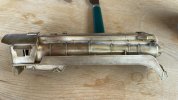Focalplane
Western Thunderer
Jim McGowen (Connoisseur Models) suggests soaking a new brush in PVA and let it dry before using. The brush lasts a lot longer so presumably fewer shards come loose when being used. A win win concept!
All I got from soaking them in PVA was something that felt like rubbing a twig on the model - lots of friction, no abrasion.
The pain of the shards is not too bad and disappears after a few days. Try forgetting you've just cut chilli peppers and going to the loo if you want pain.
Simon, I use a micro torch to solder which doesn't leave too much to clean up and minimises the need to use the brush.Ok, Max, how do you use them?

Simon, I use a micro torch to solder which doesn't leave too much to clean up and minimises the need to use the brush.
Then it is down to a scraper to remove the majority of the solder and finally I try to keep the length of fibre as short as is practical.
What tends to come off is more dust like rather than longer fibres.
